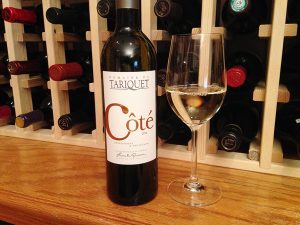Trinity Hill Pinot Noir New Zealand 2013: Supple sipper, velvety smooth; ripe cherries, strawberry, raspberry, plum; medium body, low oak, fresh, bright with engaging touch of tartness; smooth-grained tannin, reserved alcohol (13%). Really nice NZ pinot value that fearlessly bucks trend to blowzy, big-oak, and hyped alcohol contrivances some value pinot producers pursue. This is has much more of the refined elegance of a pricier Burgundy or Washington-Oregon classically made pour. Continuing proof New Zealand makes some great wines beyond sauv blanc. $17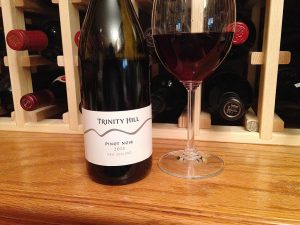
Month: July 2015
Michael-David Inkblot Cabernet Franc 2013
Michael-David Inkblot Cabernet Franc 2013: Very dense, full body with bushels of black cherry, plum, blackberry, some graphite, a tingle of blackcurrant tang; touch of pepper on the nose; smooth tannin, soft acidity, oaked (but not obnoxiously so—18 months in French). Lodi hardly is a cab franc capitol, but Michael-David regularly defies convention to make plush, bold, big flavors from their ripe Central Valley grapes. You encounter cab franc more often as a blending grape to contribute its inky color (M-D got the name right), and more often in America as a varietal from Washington-Oregon or the Finger Lakes of New York, but M-D pulls it off, as they typically do with all their offerings. If your fancy drifts to delicate and ethereal, M-D efforts likely are not for you. If you enjoy wines you can chew and fruits that flood every cell in your mouth with juicy flavor, this Lodi leader has your back again. $35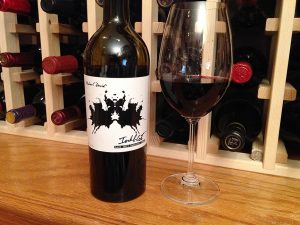
E. Guigal Côtes du Rhône White 2013
E. Guigal Côtes du Rhône White 2013: Wonderful blend of 65% viognier, 15% roussanne, 10% marsanne, 8% clairette, 2% bourboulenc; combined they create delightful complexity, depth, and richness. Very pale yellow color, flower petals on the nose—after some exposure to air; delicate honeysuckle, pear, apricot, white peach on the palate. Guigal historically features viognier in their blanc, and this offering affirms that judgment. Full body, dry, smooth, no oak, brush of crisp fruitiness, some minerality and ginger on clean, cleansing finish. E. Guigal is a go-to quality-value play year after year, and this delight deliciously sustains their record. $14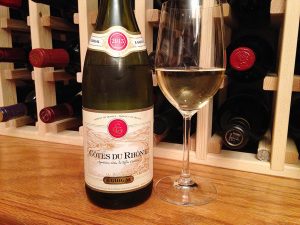
Pedernales Cellars Texas Tempranillo 2012
Pedernales Cellars Texas Tempranillo 2012: Bright cherry, raspberry, smoky minerals on enchanting nose; raspberry, cherry, blackberry, plum, chip of chocolate, bit of balsamic, spice on the palate; dash of vanilla, appropriate oak; medium-plus body, restrained acidity and tannin, interesting tang on lingering finish. Pedernales Cellars is a premier Texas maker with admirable commitment to sustainable viticulture and ecological reverence. The sixth generation Texans who own and run the operation have particular focus on tempranillo and viognier—grapes that appear destined to be signature Texas varieties. This is seriously good serious red wine at a fair price (which doesn’t always happen with Texas bottlings). Enjoy. $17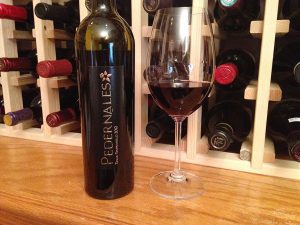
Santa Cristina Bianco Umbria 2013
Santa Cristina Bianco Umbria 2013: Crisp, zippy citrus, peach nose; Granny Smith apple, orange rind, whisper of fruity sweetness, pinch of pear and peach on the palate; excellent acidity, retains its clean freshness through the finish; this is excellent alternative to sauvignon blanc and pinot grigio. Very pale yellow in color, blend of grechetto and procanico grapes; grechetto in particular is classic grape of Umbria, a region in central Italy. Umbria is the only Italian region that has no coastline or border with another country; its most famous towns are Assisi (associated with St. Francis) and Norcia (associated with St. Benedict). The Antinori family makes this wine, as they have been doing in Umbria for more than 600 years—26 generations dating back to 1385. They’ve figured out how to make wine, as this effort attests. You don’t last that long by lounging on laurels and the family pursues modern winemaking techniques and tastes; they now also make wine in Napa, Chile, and Hungary. This is savory delight that evolves and improves with air; its vibrant acidity and freshness pairs it superbly with many foods. $11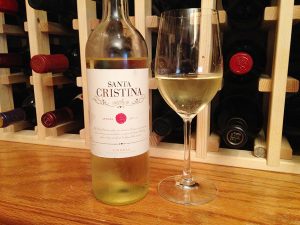
Simi Alexander Valley Cabernet Sauvignon 2012
Simi Alexander Valley Cabernet Sauvignon 2012: Nice enough effort; expected soft tannin and greenness of Alexander Valley red; plenty of cherry, berry, some black currant tang on the tongue, somewhat restrained oak; scores points for creaminess, smoothness, spice on the finish; fruit-forward, but lacks balance and falls short of overall wonder for the price. It you enjoy big fruit-oak a’plenty Cal cabs, give this a shot to see if you disagree with my evaluation. Certainly not terrible, but not compelling joy either. Alas. $21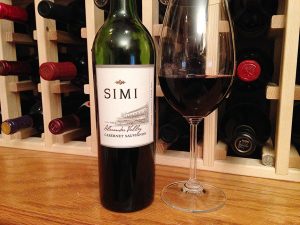
Becker Vineyards Chardonnay 2013
Becker Vineyards Chardonnay 2013: Value-focused chard; rich, plenty of oak and buttery softness on the palate, balanced with acidity; oranges, lemon-lime; whiff of thyme or lavender herbaceousness on the nose; easy drinker, simple, full flavored if somewhat one-dimensional. Becker makes this at its beautiful winery-tasting room-shop in Stonewall; the venue is a must-visit on the Texas Wine Trail in the Hill Country. It almost certainly is made with out-of-state grapes; the “For Sale in Texas Only” on the label is the tell; in one of the quirks of our country’s ridiculous mess of wine/alcohol laws and rules, you don’t have to tell consumers the source of your grapes if you don’t sell outside your state. If this had been made with Texas-grown grapes, Becker would brag about it. Likely, this juice comes from California’s Central Valley, but that’s just informed guess. The pleasant pour is at least made in Texas (the juice got here as quick as it could). $9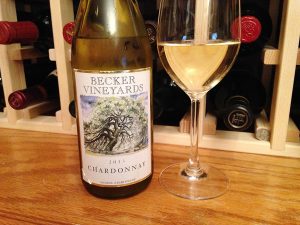
Vina Robles Cabernet Sauvignon 2012
Vina Robles Cabernet Sauvignon 2012: Excellent Paso Robles effort made with satisfying restraint; big, juicy fruit, blackberries, plum, black cherry, blueberry, vanilla; creamy mouth with structure and complexity for the price. Cab aged mainly in French oak, but some in American and Hungarian oak, for eight months, then petit verdot and tannat were added for structure and freshness. Final blend aged an additional year in oak to integrate the flavors. In spite of 20 months in various oaks, this remarkably is not frightening oak monster. Vina Robles cabs regularly score very well, and this carries on the tradition and exhibits skill in blending and use of oak. It is medium-full bodied, modest alcohol (13.7%) for Cal cab, balanced, good acidity and well-behaved tannin, a tasty change of pace from massive Napa cabs. Paso Robles is rising star wine growing area at southern end of California Central Coast region; at some 666,500 acres, it is one of California’s largest regions, covering northern half of San Luis Obispo County. It consistently produces rich, ripe reds from warm-climate grape varieties. This smoothly delicious effort is clearly worth a cork-pull on your wine bucket list. $21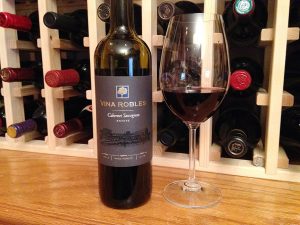
Kim Crawford Unoaked Chardonnay 2014
Kim Crawford Unoaked Chardonnay 2014: Light straw color, lilt of grapefruit on the nose; peach, lemon meringue, tropic fruit, pinch of pineapple on the palate; crisp, light and creamy, medium texture, nice acidity, some complexity from five months of aging on the lees, but a simple, straightforward chard at its core. With no oak, you get a pure east coast of New Zealand (Marlborough and Hawke’s Bay fruit) chard with this pour. Kim Crawford is one of the NZ standard bearers in world-wide wine; it started making wine in 1996, and unoaked chardonnay was the first bottling. The chardonnay grape is extremely versatile and can be made in let-the-fruit-speak-for-itself style such as this, or as tricked-up oak-and-butter monsters that soared in popularity in the1980s. Chardonnay is the world’s second-most planted white wine grape, behind only Spain’s airén—and that only if you measure by acreage (airén vines are much more widely spaced). Oak can be used like pancake makeup to trowel over flaws; unoaked gives you chard pure and simple. This is clean, fresh, charmingly guileless. $16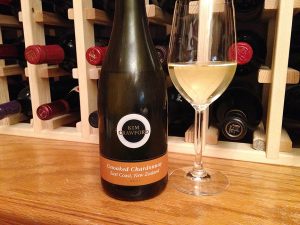
Domaine du Tariquet Côté Chardonnay et Sauvignon 2014
Domaine du Tariquet Côté Chardonnay et Sauvignon 2014: Interesting equal blend of chard and sauv blanc; flowers, spice, grapefruit, citrus, melon, minerals, hint of sweetness; the effort provides fresh, delightful surprises. Magic of the mix is interplay of chard’s rich, buttery, roundness and sauv blanc’s aromatics, zingy freshness and cleansing acidity; chard is fermented in barrel, sauv blanc in stainless steel. Winemaker Yves Grassa often is described as brilliant and innovative, and this distinctive and delicious blend is an example. Chard-sauv blanc blends are made around the world and are more common than many realize, but Grassa’s 50-50 approach is not standard. Enjoy how his effort plays with your palate in evolving ways, and ways you probably have never had your palate played with before. This come’s from Côtes de Gascogne region in southwest France, inland from the Atlantic and north of the Pyrénées, Toulouse is major city to the east. Gascogne (Gascony to the English) is one of France’s leading producers of white wine for export—some 75% of its 100 million-plus bottles each year are sold for export. $11